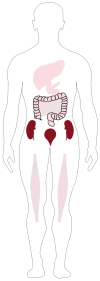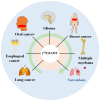L-3-[18F]-Fluoro-α-Methyl Tyrosine as a PET Tracer for Tumor Diagnosis: A Systematic Review from Mechanisms to Clinical Applications
- PMID: 40565308
- PMCID: PMC12193167
- DOI: 10.3390/ijms26125848
L-3-[18F]-Fluoro-α-Methyl Tyrosine as a PET Tracer for Tumor Diagnosis: A Systematic Review from Mechanisms to Clinical Applications
Abstract
L-3-[18F]-fluoro-α-methyl tyrosine ([18F]FAMT) is an amino acid positron emission tomography (PET) tracer with high specificity for malignant tumors through its selective transport via L-type amino acid transporter (LAT) 1. Although extensively studied for its diagnostic performance, a comprehensive review of its molecular and clinical characteristics remains lacking. A systematic literature review (1997-2025) was conducted using PubMed and Web of Science, with keywords including "L-3-[18F]-fluoro-α-methyl tyrosine", "[18F]FAMT", "amino acid PET", and "tumor imaging". The review covered aspects of synthesis, structural properties, pharmacokinetics, and clinical applications. Notably, while research on [18F]FAMT has declined significantly in recent years, [18F]FAMT PET demonstrates superior specificity to [18F]FDG PET in distinguishing malignancies from inflammatory lesions and offers distinct advantages in lung, esophageal, and oral cancers, though with slightly lower sensitivity. Its key features include tumor-specific uptake patterns, rapid blood clearance, and a significant correlation between its uptake levels and both LAT1 expression and tumor proliferation. In conclusion, [18F]FAMT is a promising PET tracer with notable advantages in tumor imaging, particularly due to its LAT1 selectivity and favorable pharmacokinetics. Despite challenges in production, these characteristics underscore its clinical value in cancers requiring precise imaging. Future research should focus on optimizing synthesis, expanding clinical validation, and exploring theranostic applications.
Keywords: LAT1; [18F]FAMT; amino acid PET; molecular imaging; treatment response assessment; tumor diagnosis.
Conflict of interest statement
The authors declare no conflicts of interest.
Figures






Similar articles
-
Biological evaluation of 3-[(18)F]fluoro-α-methyl-D-tyrosine (D-[(18)F]FAMT) as a novel amino acid tracer for positron emission tomography.Ann Nucl Med. 2013 May;27(4):314-24. doi: 10.1007/s12149-013-0687-7. Epub 2013 Jan 23. Ann Nucl Med. 2013. PMID: 23337966
-
Transport of 3-fluoro-L-α-methyl-tyrosine by tumor-upregulated L-type amino acid transporter 1: a cause of the tumor uptake in PET.J Nucl Med. 2012 Aug;53(8):1253-61. doi: 10.2967/jnumed.112.103069. Epub 2012 Jun 28. J Nucl Med. 2012. PMID: 22743251
-
The value of FDG positron emission tomography/computerised tomography (PET/CT) in pre-operative staging of colorectal cancer: a systematic review and economic evaluation.Health Technol Assess. 2011 Sep;15(35):1-192, iii-iv. doi: 10.3310/hta15350. Health Technol Assess. 2011. PMID: 21958472 Free PMC article.
-
18F PET with florbetapir for the early diagnosis of Alzheimer's disease dementia and other dementias in people with mild cognitive impairment (MCI).Cochrane Database Syst Rev. 2017 Nov 22;11(11):CD012216. doi: 10.1002/14651858.CD012216.pub2. Cochrane Database Syst Rev. 2017. PMID: 29164603 Free PMC article.
-
18F PET with flutemetamol for the early diagnosis of Alzheimer's disease dementia and other dementias in people with mild cognitive impairment (MCI).Cochrane Database Syst Rev. 2017 Nov 22;11(11):CD012884. doi: 10.1002/14651858.CD012884. Cochrane Database Syst Rev. 2017. PMID: 29164602 Free PMC article.
References
-
- Avril N. GLUT1 expression in tissue and (18)F-FDG uptake. J. Nucl. Med. 2004;45:930–932. - PubMed
Publication types
MeSH terms
Substances
Grants and funding
LinkOut - more resources
Full Text Sources
Medical
Research Materials

